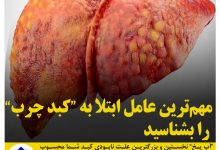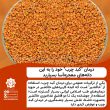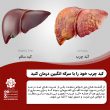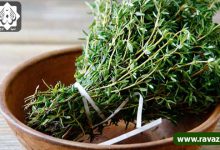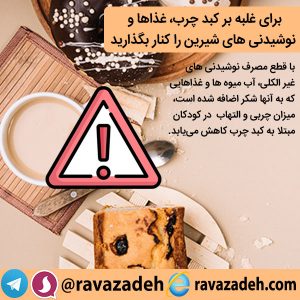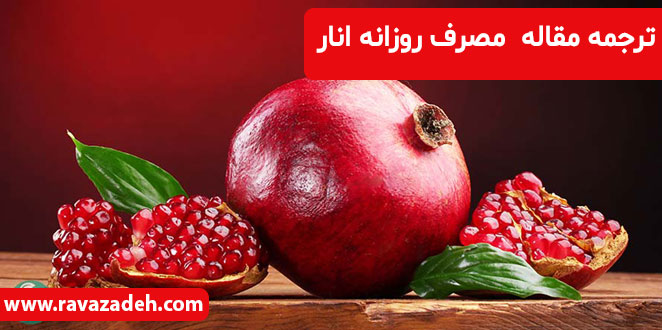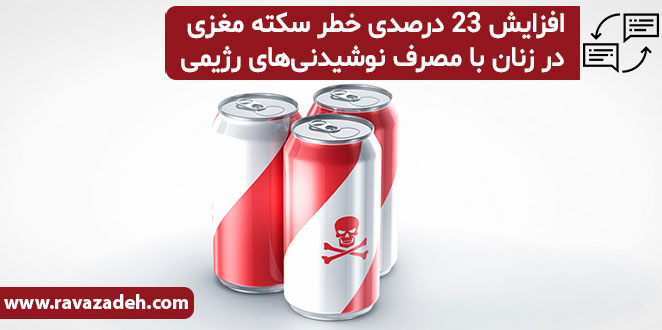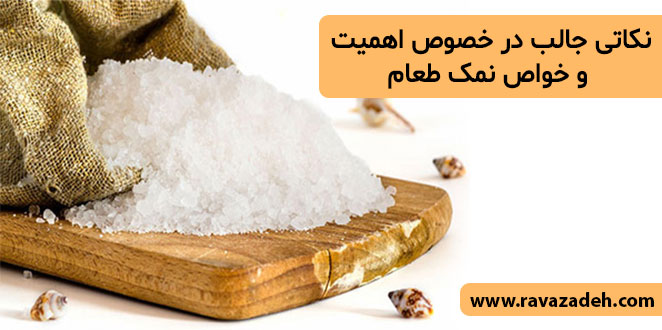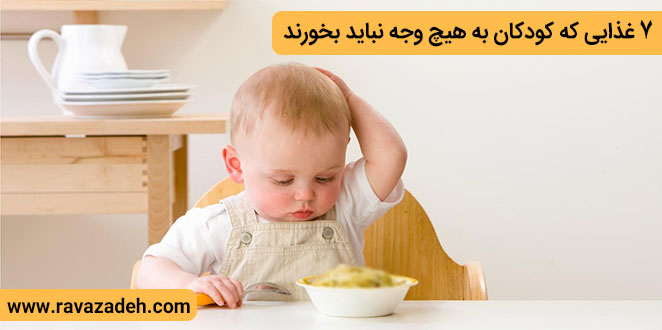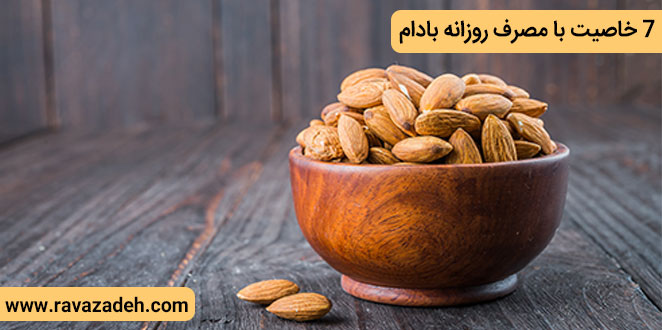ترجمه مقاله >> برای غلبه بر کبد چرب، غذاها و نوشیدنی های شیرین را کنار بگذارید
با قطع مصرف نوشیدنی های غیر الکلی، آب میوه ها و غذاهایی که به آنها شکر اضافه شده است، میزان چربی و التهاب در کودکان مبتلا به کبد چرب کاهش مییابد.
یافتههای جدید ترین مطالعات نشان میدهد که با قطع مصرف نوشیدنیهای غیر الکلی، آب میوه ها و غذاهایی که به آنها شکر اضافه شده است، میزان چربی و التهاب در کودکان مبتلا به کبد چرب کاهش مییابد.
تحقیقات جدید که در JAMA منتشر شده است، نشان میدهد که محدود کردن مصرف مواد غذایی و نوشیدنیهای شیرین، استراتژی سبک زندگی نوید بخشی است که بیماریهای ویرانگر مرتبط با بحران چاقی را که در دنیای امروز بین بزرگسالان و کودکان در حال گسترش است را کاهش میدهد. این طور برآورد میشود که 80 درصد از مردم آمریکا مبتلا به بیماری کبد چرب غیر الکلی هستند که کبد را در معرض سطوح بالای چربی قرار میدهد.
معمولا کبد چرب نشانههای کمی دارد و بیشتر افراد مبتلا، از داشتن بیماری آگاه نیستند. ولی کبد چرب خطر ابتلا به دیابت نوع 2 را افزایش میدهد و به بیماری خطرناکتری که به آن التهاب کبدی غیر الکی میگویند مبتلا شوند. التهاب کبدی غیر الکلی مهمترین عامل ابتلا به سرطان کبد، التهاب شدید کبد (سیروز کبد) و پیوند کبد است.
اگرچه رهنمودهای فعلی در خصوص ورزش کردن و داشتن رژیم غذایی سالم برای کودکان مبتلا به کبد چرب غذای خاصی را مد نظر قرار نداده است ولی تعدادی از کارشناسان به بیماران مبتلا به کبد چرب توصیه میکنند که از خوردن غذاهایی که در طی فرآیند تولید به آنها شکر اضافه میشود، خودداری کنند. شکر اضافه شده دارای مقادیر زیادی فروکتوز است که منجر به افزایش تولید چربی از طریق متابولیسم در کبد میشود.
به گفته دکتر میریام وس نویسنده تحقیق جدید و استادیار دانشگاه کودکان اموری ، ” استانداردهای جدید مراقبت به آنچه که به هر کودکی که اضافه وزن دارد، توصیه میکنیم، شبیه است. متاسفانه توصیههای عمومی، آنطور که انتظار داشتیم به بهبود این بیماری منجر نشد. ضمن این که آزمایشهای تصادفی بزرگی هم برای تعیین بهترین رژیم غذایی انجام نشده است”.
دکتر وس و همکارانش برای مطالعه جدید از 40 کودک مبتلا به کبد چرب با میانگین سنی 13 سال استفاده کردند. اکثر آنها اسپانیایی بودند، گروهی که کبد چرب در میانشان شیوع بیشتری دارد ( به طور میانگین بین 21 و 25 درصد) . بیشتر از چهر برابر نرمال.
محققان سپس کودکان را در یکی از دو گروه رژیم غذایی برای 8 هفته قرار دادند.
در گروه اول مصرف غذای با شکر اضافه شده، محدود شد ولی در گروه دوم که گروه کنترل بود، رژیم عادی غذایی خودشان را داشتند. به کودکان در خصوص اجتناب یا کاهش مصرف شکر، توصیهای نشده بود.
برای این که تحمل رژیم برای گروه اول راحت تر شود، محققان از خانواده کودکان خواستند که آنها نیز از رژیم تبعیت کنند. محققان رژیم را با توجه به نیاز هر خانواده با آزمون میزان غذای مصرفی در یک هفته و سپس جایگزینی آن با غذاهای کم شکر تنظیم کردند. مثلا اگر خانوادهای در حالت عادی شکر، سس، سس سالاد و نان با افزدونی شکر میخورد، محققان همان غذاها را تهیه کردند ولی غذاهایی که شکر نداشت.
آب میوهها، نوشیدنیهای غیر الکلی و سایر نوشیدنیهای شیرین نیز ممنوع بودند. این مواد غذایی با شیر، آب، یخ چای و سایر نوشیدنیهای بدون شکر جایگزین شدند. متخصصین تغذیه هفته ای دوبار غذاها را برای خانوادهها تهیه میکردند که به خانواده ها در باقی ماندن بر برنامه کمک میکرد.
در نهایت، رژیم کم شکر به طور شدید محدود نشده بود. این رژیم کم کربو هیدرات نبود یا در میزان کالری محدودیتی نداشت. کودکان میتوانستند میوه، نشاسته و پاستا به هر میزان که تمایل داشتند، بخورند. ولی هدف این بود که میزان دریافت شکراضافی در این کودکان به کمتر از 3 درصد کالری روزانه، کمتر از 5 تا 10 درصد برای بزرگسالان و کودکان مطابق با توصیه سازمان بهداشت جهانی برسد.
پس از 8 هفته، میزان دریافت شکر برای گروه کم شکر فقط به 1 درصد کالری روزانه در مقایسه با گروه کنترل که 9 درصد بود، کاهش یافت. همچنین در این گروه تغییر قابل ملاحظهای در سلامت کبد این افراد مشاهده شد. چربی کبد به طور میانگین به میزان 31 درصد در مقایسه با گروه کنترل کاهش یافت. ضمن این که کاهش 40 درصدی در سطح آلانین آمینوترانزفراز یا (ALT) نیز مشاهده شد. (ALT) آنزیمی کبدی است که هنگامی که سلولهای کبد آسیب ببینند یا ملتهب شوند، ترشح میشود.
دکتر وس میگوید: به عنوان یک هپاتولوژیست، من به صورت هفتگی کودکانی را میبینم که دچار کبد چرب هستند و عاشق این هستم که در بیمارانم بهبود ببینم. این بخش از آزمایش نه تنها باعث کاهش سطح چربی شد بلکه آنزیم کبدی نیز بهبود یافت. همچنین کاهش التهاب نیز مشاهده شد”.
مطالعه جدید توسط موسسه علوم تغذیه تامین مالی شده است. این موسسه توسط گری تایوبز که روزنامه گار در حوزه علم و سلامت است، تاسیس شده است. وی طرفدار سرسخت رژیم کم کربو هیدرات است. موسسه ملی سلامت، دانشگاه مراقبت از کودکان کالیفرنیا، سان دیه گو، آتلانتا و دانشگاه اموری نیز در تامین مالی این پروژه مشارکت داشته اند.
دکتر جویل ای لاون، کارشناسی که در مطالعه مشارکت نداشته است، گفته: این آزمایش به صورت هوشمندانهای طراحی شده است و نکات بسیار بااهمیتی را در خصوص بیشترین ترکیب غذایی که با کبد چرب، التهاب کبد و آسیب سلول ارتباط دارد را مشخص کرد. وی در ادامه گفت حضور همه جانبه غذاهای مضر، پیروی از این رژیم غذایی را سخت میکند ولی به عنوان یک قانون کلی پزشکان باید به بیماران خود توصیه کنند که برچسب مواد غذایی را برای شکر افزوده شده بررسی کنند و نوشیدنیهای شیرین را ننوشند.
دکتر لاوین میگوید بهترین رژیم به سادگی خرید مایحتاج خارج از قفسههای سوپر مارکتهاست که شامل غذاهای فرآوری شده، کنسروها و غذاهای بسته بندی شده است”
افراد گروه کم شکر در طی دوره مطالعه در حدود 3 پوند کاهش وزن داشتند که به بهبود عملکرد کبد قابل انتساب است.
دکتر شوییمر پروفسور در کلینیک کبد بیمارستان کودکان رادی در سان دیه گو میگوید کودکان گروه کم شکر به طور میانگین کاهش وزن اندکی داشتند ولی این مقدار اندک کاهش وزن با این میزان از بهبود مرتبط نیست. دکتر شوییمر و سایر محققین گروه در حال انجام تجزیه و تحلیل های بیشتر هستند تا ببیند چه عاملی باعث چنین تغییراتی شده است.
وی در ادامه میگوید: این تنها یک گام است و نتیجه نهایی نیست. ولی بر این مبنا، ما مطالعاتی را تصور میکنیم که آیا این درمان میتواند در نهایت به اندازه کافی بیماری را درمان کند تا مانع از سیروز کبدی شود که به سرطان کبد منتهی میشود.
در ذیل متن اصلی این مقاله ارائه می گردد:
Overweight children with fatty liver disease sharply reduced the amount of fat and inflammation in their livers by cutting soft drinks, fruit juices and foods with added sugars from their diets, a rigorous new study found.
The new research, published in JAMA on Tuesday, suggests that limiting sugary foods and drinks may be a promising lifestyle strategy to help alleviate a devastating condition linked to the obesity crisis that is spreading rapidly in adults and children. An estimated 80 million to 100 million Americans have nonalcoholic fatty liver disease, which causes the liver to swell with dangerous levels of fat. Roughly seven million of those are adolescents and teenagers.
Fatty liver disease typically has few symptoms, and many people who have it don’t know it. But fatty liver disease raises the risk of developing Type 2 diabetes and heart disease, and it can progress to a more severe condition called nonalcoholic steatohepatitis, or NASH, which is a leading cause of liver cancer, cirrhosis and liver transplants.
Current guidelines call for children who have fatty liver disease to exercise and eat a healthy diet though they do not specify particular foods. But some experts already counsel their fatty liver patients to avoid added sugars, which manufacturers commonly add to heavily processed foods and which are different than the sugars that occur naturally in foods like fruit. Added sugars are typically high in fructose, which can ramp up the production of new fat when it is metabolized by the liver.
“The current standard of care is very similar to what we would recommend for any child that is overweight,” said Dr. Miriam Vos, an author of the new study and an assistant professor of pediatrics at the Emory University School of Medicine. “Unfortunately, that general recommendation hasn’t improved the disease as much as we would like, and there are no large randomized trials looking at which diet is the best one for fatty liver.”
For the new study, Dr. Vos and her colleagues recruited 40 children, about 13 years old on average, who had fatty liver disease. Most were Hispanic, a group that has a particularly high prevalence of fatty liver disease, with an average of between 21 and 25 percent liver fat, more than four times the normal limit.
The researchers then randomly assigned the children to one of two diet groups for eight weeks.
One group limited added sugars, and the second group of children, which served as the control, remained on their usual diets. They were not given any special instructions to avoid or lower sugar.
To make the diet easier and more practical for the children in the limited-sugar group to follow, the researchers asked their families to follow it as well. They tailored the diet to the needs of each household by examining the foods they consumed in a typical week and then swapping in lower sugar alternatives. If a family routinely ate yogurts, sauces, salad dressings and breads that contained added sugar, for example, then the researchers provided them with versions of those foods that did not have sugar added to them.
Fruit juices, soft drinks and other sweet drinks were forbidden. They were replaced with unsweetened iced teas, milk, water and other nonsugary beverages. Dietitians prepared and delivered meals to the families twice a week, which helped them stick to their programs.
Ultimately, the low-sugar diet was not terribly restrictive. It was not low-carb, nor was it limited in calories. The children could eat fruit, starches and pasta, for example, and they were allowed to eat as much as they wanted. But the goal was to get their added sugar intake to less than 3 percent of their daily calories — less than the 5 to 10 percent limit for adults and children recommended by the World Health Organization.
After eight weeks, the low-sugar group had gotten their added sugar intake down to just 1 percent of their daily calories, compared to 9 percent in the control group. They also had a remarkable change in their liver health. They had a 31 percent reduction in liver fat, on average, compared to no change in the control group. They also had a 40 percent drop in their levels of alanine aminotransferase, or ALT, a liver enzyme that rises when liver cells are damaged or inflamed.
“As a practicing hepatologist, I see children weekly with fatty liver, and I would love to see this kind of improvement in my patients,” said Dr. Vos. “The exciting part was not only did the fat go down, but their liver enzymes also improved. That suggests that they also got a reduction in inflammation.”
The new study was funded in part by the Nutrition Science Initiative, a nonprofit research group that was co-founded by the science and health journalist Gary Taubes, a proponent of low-carb diets. The National Institutes of Health, the University of California, San Diego, Children’s Healthcare of Atlanta and Emory University also provided funding.
Dr. Joel E. Lavine, an expert who was not involved in the study, said it was cleverly done and demonstrated “some important points about what a major constituent of diet contributes to this problem in terms of liver fat and inflammation and cell injury.” He said the ubiquity of unhealthy foods makes such a diet difficult to follow, but that as a general rule doctors should advise patients and their families to check food labels for added sugars and to avoid or eliminate juices.
“The best diet, to make it very simple, is to shop the outside aisles in supermarkets and stay away from the middle aisles containing processed foods that come in boxes, cans and packages,” said Dr. Lavine, the chief of gastroenterology, hepatology and nutrition at Columbia University Irving Medical Center and the Morgan Stanley Children’s Hospital of NewYork-Presbyterian.
The members of the low-sugar group lost about three pounds during the study, which may have contributed to their improvements in liver health. But Dr. Jeffrey B. Schwimmer, an author of the study, said it was unlikely to account for the large changes.
The children on the low sugar diet did lose a few pounds on average, but that amount of weight loss has never been associated with this degree of improvement,” said Dr. Schwimmer, a professor of pediatrics at the University of California, San Diego, and the director of the Fatty Liver Clinic at Rady Children’s Hospital in San Diego. He and his co-authors are doing follow-up analyses to find out more about what accounted for the liver changes.
“This is a step, it’s not the final word,” Dr. Schwimmer said. “But based on this, we would envision studies that look at whether this therapy can actually treat the disease well enough to prevent cirrhosis, end-stage liver disease and liver cancer.”
